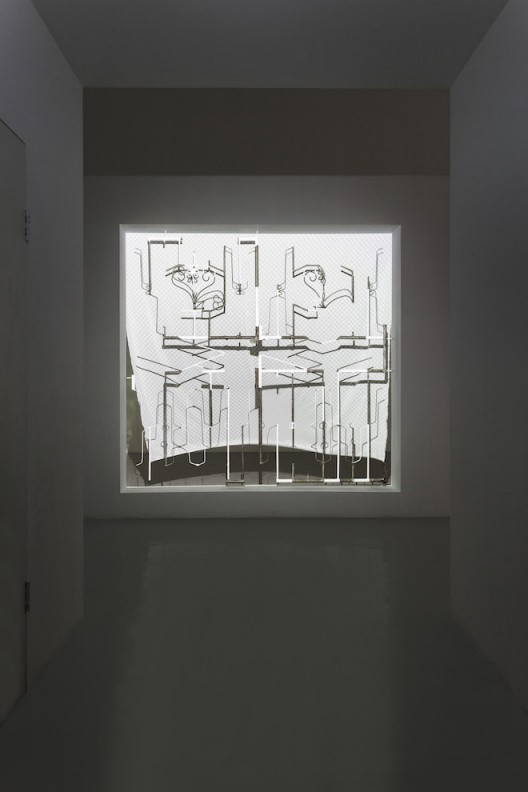Liu Chuang Solo Exhibition: Live Remnants
Magician Space (798 East Road, 798 Art District, No.2 Jiuxianqiao Road, Chaoyang District, Beijing ), Oct 27, 2015–Dec 6, 2015
The ancient yet still ubiquitous fangsheng motif (a double overlapped square motif commonly used on railings or window patterning) is a sight easily overlooked in everyday life in China. It is a natural and yet barely perceptible testament to an age-old aesthetic template or abstract form. In Liu Chuang’s solo show “Live Remnants” at Magician Space, the artist has overlaid the fangsheng motif—as metal bars of a window—in front of a projector through which a photoshopped image is shone. A checkered cloth hangs in front of the window and flutters in an artificial breeze. Light fixtures with bulbs replaced by porcelain or glass bottles lie off to one side on the floor or dangle from the ceiling, projecting two-toned fangsheng motifs.
All this seems at first sight unrelated to the rampant seasonality of the willow catkin fluff in Liu’s video work “No. 1 Blossom Bud Restrainer”. Purportedly genetically modified with hormone injections, these willow trees and their catkin fluff permeate almost every corner of Beijing. Clearly, Liu Chuang is attempting to present an aperture beyond a world conventionally perceived by means of an archaeology of knowledge.
Such an (apparent) genealogical analysis threatens modernity as we perceive it. As we continue to accumulate trifle details, we begin to doubt the reality of our perception. Humanity uses “civilized” methods to manage the natural development of vegetation, but we lose control and are upended, regressing to a passive state by such willow catkins—whose transplantation is also a by-product of civilization. If not for the modified lighting fixtures and their ethereal light as well as the poetry of the cool, serene light flooding in, the juxtaposition of a physical object (a syringe for injecting plant hormones) would have greater explicatory significance. The original documentary source material and intentionally implanted documentary-like dialogues (in the video) leave little room for poetry. Clearly, the artist intends to hew to a naturalistic approach, implanting the history of natural objects within a larger context—and thus inciting our wariness of our commonplace certainty in our modernity.

刘窗,《什么是屏幕?》,铁、油漆、投影、电扇、印花织物,220×210cm,2015@魔金石空间

刘窗,《BBR1(抑花一号)No.2》,录像,8′25′′,2015@魔金石空间

刘窗,《BBR1(抑花一号)No.2》,录像,8′25′′,2015@魔金石空间

刘窗,《BBR1(抑花一号)No.2》,录像,8′25′′,2015@魔金石空间

刘窗,《无题》,瓷器、LED灯、电线,27×19 cm,2015@魔金石空间

刘窗,《什么是屏幕?》,铁、油漆、投影、电扇、印花织物,220×210cm,2015@魔金石空间